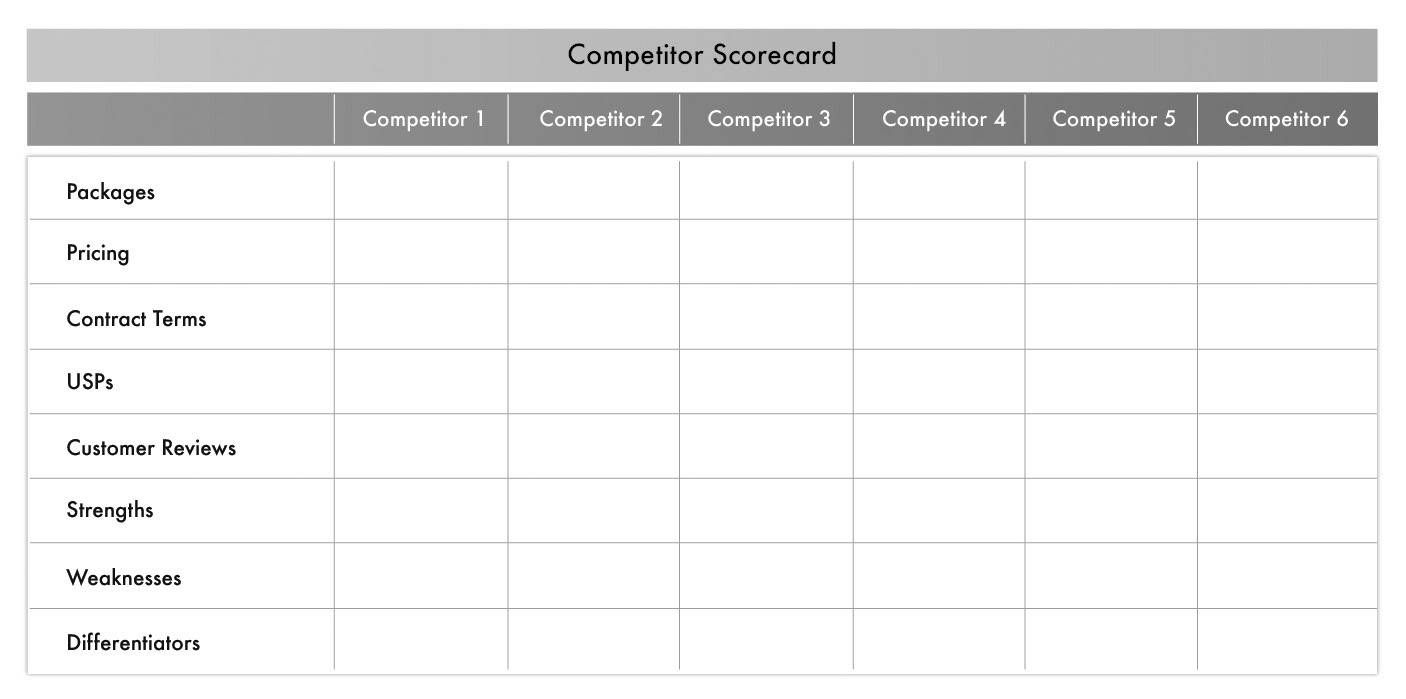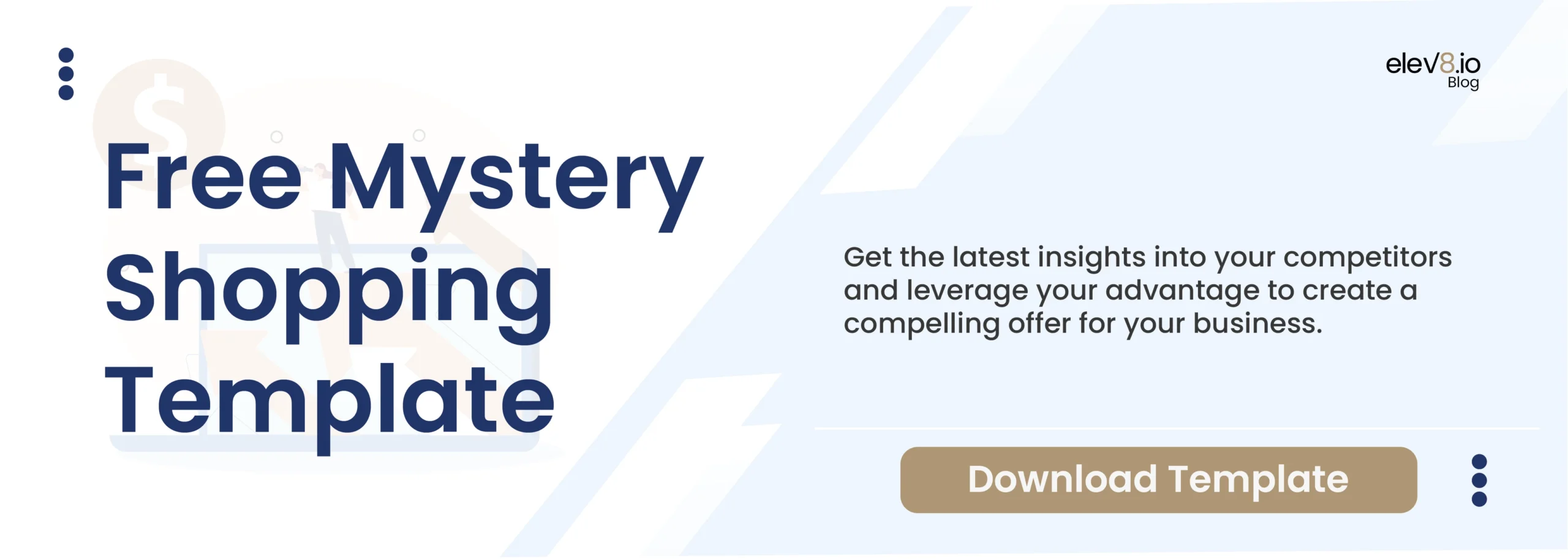If you run a B2B or SaaS business, you need a competitive intelligence strategy to stay ahead of the game as you strive to become the “go-to” provider in your space.
But do you know enough about your competitors to be able to properly differentiate from them?
Are your sales reps demoralized because they don’t have the competitive information they need to win deals? Or are your marketing efforts not producing sufficient MQLs for the same reason?
One way to create a clear picture of your competitors is to use mystery shopping and competitive scorecards. These techniques allow you to gain insights into how your competitors are operating.
Here’s what you need to know about using these strategies for competitive intelligence in B2B and SaaS.
What is Mystery Shopping?
Traditionally, mystery shopping is a process innovated in the financial services and consumer packaged goods industry in which anonymous shoppers, also known as “mystery shoppers”, visit their competitors’ stores or websites and evaluate their customer service experience.
This can be done both online and offline, depending on the type of business. Mystery shoppers are typically paid for their services and provide detailed reports of their findings. However this technique has been relatively little used in the B2B or SaaS sectors, given its focus on end-customer surveys.
I learned of the power and benefits that mystery shopping could play in B2B when Google introduced me to the concept. I was blown away and have consistently adopted these methods ever since.
The Benefits of Mystery Shopping
Mystery shopping is an efficient way to gain direct first-hand intel on a competitor, ideally before you go to market with your product or service. Three key benefits include:
- This is information you wouldn’t normally have access to. It also allows you to observe your competitors’ strategies, giving you insight into how your competitors are operating and what strategies may be working best for them.
- Additionally, mystery shopping helps businesses identify areas where they can improve their own operations, such as pricing, product offerings or customer service.
- Finally, it can provide businesses with valuable feedback from customers who have experienced their products or services firsthand.
In B2B, mystery shopping is primarily conducted in an interview format, where you have a legitimate reason to gain such an interview.
The process can be conducted virtually which makes it easier to simultaneously conduct an interview and collect the data of what was said.
Another more traditional way is through face-to-face meetings at trade show booths, although the quality of the information is often filtered through the other party’s “booth sales talk”.
For B2B and SaaS companies, mystery shopping can be used to observe how other companies are handling customer service inquiries and interactions with potential clients.
It can also help identify areas where they may need improvement in order to stay competitive in the market.
For example, understanding where a competitor has a better differentiated product offering can provide insight into ways to improve yours.
Or if they have more efficient customer service could be a sign that you need to invest in better tools or training programs for your staff to remain competitive.
The same holds true for SaaS companies. Mystery shopping can help them uncover areas where they may need improvement or changes in order to compete effectively against other software providers in the market.
For example, if one software provider has more features than another but doesn’t offer any support or training options, this could be an area where you may need to invest to remain competitive.
A Three-Step Process
I’ve developed a process that has proven effective and with an accompanying set of questions and a spreadsheet. Typically there are three phases to a mystery shopping exercise: 1) Research 2) Interview 3) Analysis. Each has its own steps.
With the summary sheet you can relatively easily do a comparative analysis of the competitors interviewed. It can be the basis for a living document that marketing owns and has responsibility to maintain.
In summary, the mystery shopping analysis can be a powerful tool to:
- Craft winning solutions with compelling differentiating factors on product, service and price, all based on data
- Quickly and effectively educate sales staff and new hires
- Rapidly create winning proposals
- Create alignment on interdepartmental priorities (what do we need to agree and do collectively to beat the competition)
- Contribute to the competitor scorecard (continue reading)
Build and Maintain Your Competitor Scorecard
The results and analysis from your mystery shopping study will likely be massive. And while very beneficial, it can be overwhelming for your average employee to decipher.
Instead, extrapolate the key insights from your analysis and put them into bite-size, easy-to-view chunks in a competitive scorecard. With this comparative data you can identify, for all your client-facing staff, which competitor(s) they are up against when conducting sales calls and how to respond.
This strategy can be especially beneficial for B2B and SaaS companies. So let’s explore how competitive scorecards can help your company gain an edge in the market.
What Is a Competitive Scorecard?
A competitive scorecard is a tool you can use to evaluate your competitors based on certain criteria and then track progress over time.
It allows you to assess your competitors’ strengths and weaknesses, helping you identify where you have an edge or if there are areas where you need to play catch-up.
These scorecards can then be used as a baseline for future decisions about sales, pricing models, marketing strategies and product development.
How Can B2B & SaaS Companies Use Competitive Scorecards?
Competitive scorecards are particularly useful for B2B and SaaS companies because they can provide invaluable insight into the buying patterns of other businesses in the same industry.
By understanding what other companies are offering, including:
- Features
- Pricing models
- Customer service
- Capabilities
—you can create targeted campaigns that focus specifically on these points of differentiation to win more deals.
In addition, competitive scorecards allow you to track changes in the industry over time so that you can adjust your approach accordingly.
By analyzing competitor data regularly—for example, looking at changes in customer sentiment or new product launches—you will be able to make informed decisions about how best to position yourself in the marketplace moving forward.
This could also include seeing what tactics are working for other businesses or determining which ones may have plateaued or declined due to recent changes within the industry.
Information on my Competitor Scorecards varies from project to project but usually includes the following, informed in part by the Mystery Shopping Summary:

Advantages of Competitive Scorecards
Competitive scorecards offer many advantages for B2B and SaaS companies looking to get ahead of their competition. They allow you to understand what other businesses are doing so that you can better craft your own strategies based on this knowledge. They also enable you to monitor changes over time so that you can make adjustments accordingly. In short, competitive scorecards are an invaluable tool for companies looking for an edge in their market space.
I learned this by coincidence years back, as a Google Premier Partner. They conducted a mystery shopping process with us using both an inbound call and submitting a contact form with a fictitious SMB. They later scored our approach from A-Z and stacked us up against our peers (anonymously). This lightbulb moment led me to always create similar scorecards for myself and my reps that I continuously update so they’re always at our fingertips when needed.
Strategic Tools for Competitive Intelligence
Mystery shopping combined with competitive scorecards are very effective tools for gaining high quality competitive intelligence your business might not otherwise have access to. By observing competitor operations from an outside perspective, you can uncover areas of improvement needed within your operations to keep you ahead of the competition in B2B and SaaS markets alike.
With careful planning and execution of a well-crafted mystery shopping program and competitive scorecard, you can gain invaluable insights into how your competitors operate. This will inform your decisions about how to clearly differentiate your product or service offering to outcompete your competitors, win customers and serve them well. Why not get started now?







